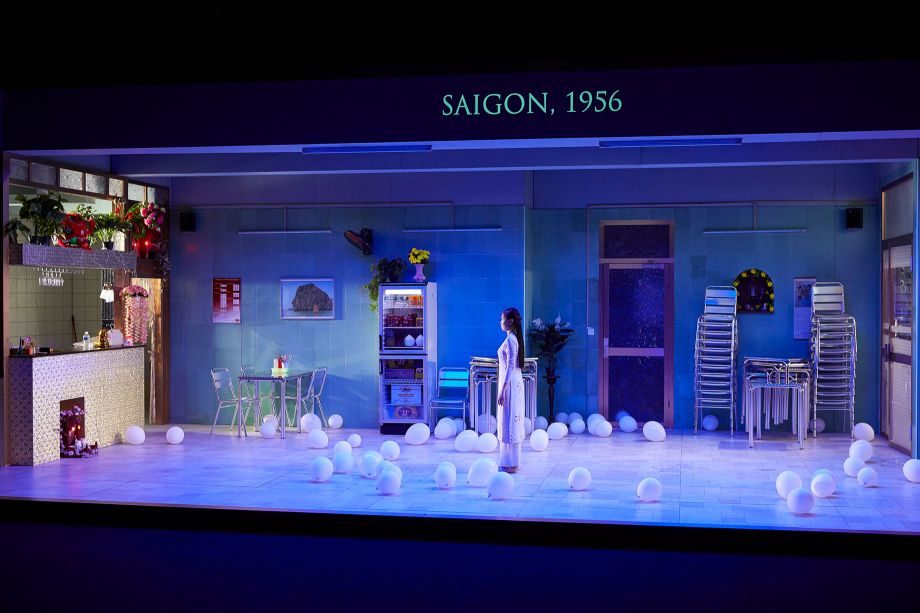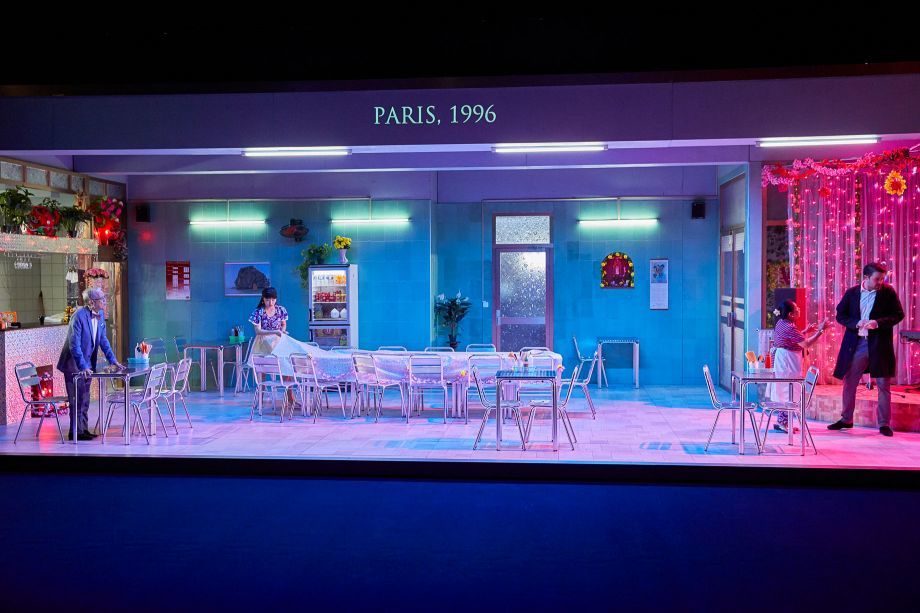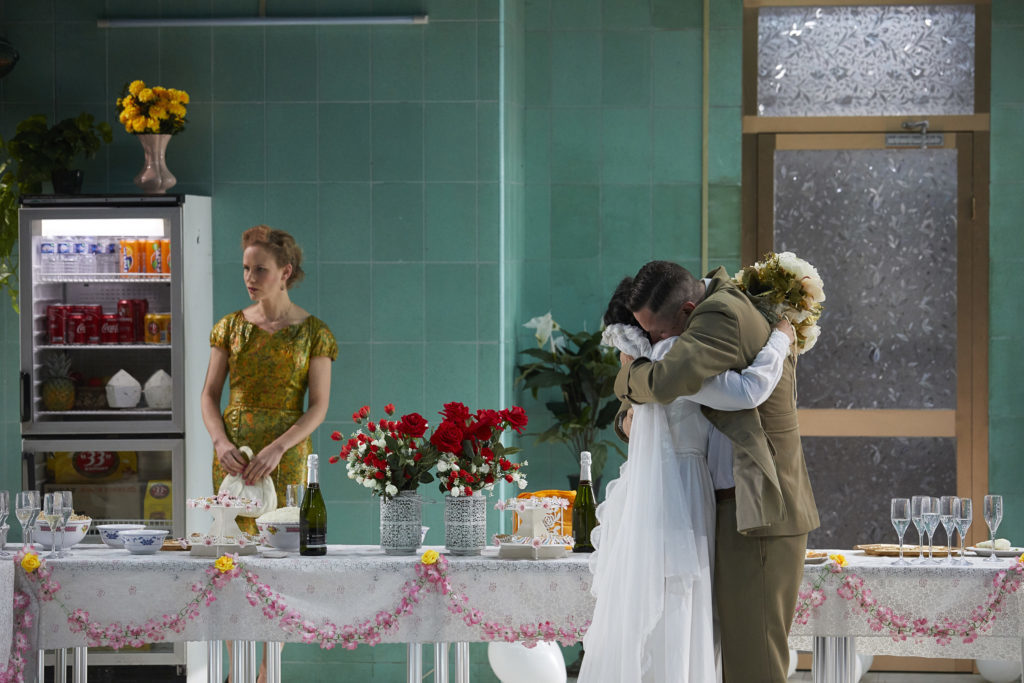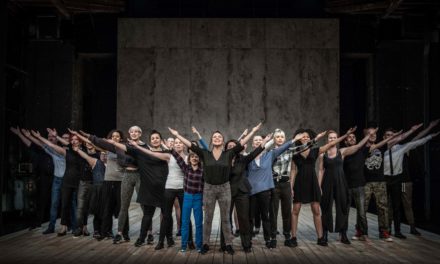In Saigon, Caroline Guiela Nguyen has created a four-hour theatrical tale based on the history of Vietnam. Its story centres on colonialism and the struggle for independence reflected in the lives of several Vietnamese families, who left Saigon for France. Nguyen is an offspring of this exodus. For her, the post-colonial history of Vietnam, and the history of Hồ Chí Minh–city, the city of Saigon, the one that “we can tell only with tears in our eyes,” is part of her identity and her artistic exploration. The play captures the drama of departures and returns, the tragedy of unfulfilled hopes and the suffering of misunderstanding.
The performance centres around a Vietnamese restaurant called “Saigon.” The set design features a meticulous replica of a cheap “oriental” restaurant, one can find in any large urban city. The action oscillates between 1956, the first year of post-independence Vietnam, and 1996, the year of François Mitterrand’s death, the first French President ever to visit Vietnam in its modern history. This time frame is also important as it presents the forty years before the Vietnamese political exiles or economic immigrants were given the right to return. The characters, we meet in the restaurant “Saigon,” are all the victims of this history.
However, no story of exile can be told without laughter and hope. This one was inspired not only by the director’s personal experiences (her mother immigrated to France in 1956) but also by the interviews she conducted with many Vietnamese immigrants and those who stayed behind. This autobiographical theatre is an attempt to paint a new historical landscape, in which the experience of travelling is the major characteristic. This landscape is marked by everyday struggles and celebrations of the people who come to Saigon to be together, to speak their language, to sing the songs of their country, to keep this history alive for their French children.
In the centre of this historical passage is Marie-Antoinette, working in the restaurant to serve the food of Hồ Chí Minh and give its people a chance to re-connect and recuperate in the new culture of the Western world. In 1938, Marie-Antoinette’s son was recruited by the French government as an interpreter but he was killed in France during the war. She is here now to keep his memory alive. There are also Linh and Edouard, who met in Vietnam when he was stationed there. They fell in love but now he has to leave for France. For them to be together, Linh would need to obtain a French passport and thus they would have to be married, But the marriage fell through as Edouard ‘s family would never accept someone like Linh as their own. He left, she went to France alone, with their child. Other star-crossed lovers are Mai and Hao, he left for France seeking safety, she stayed behind without hope of love or happiness.
Played by French and Vietnamese actors, as well as French amateur performers of Vietnamese descent, the dialogue unfolds in native French and native Vietnamese as well as in a heavily accented French and its Franco-Vietnamese version of the immigrants’ lingua franca. The actors do not put on fake accents, they use their own linguistic abilities and knowledge of each other’s cultures as they would in real life. The spectators rarely get translations, the international and domestic French audiences are forced to listen carefully if they wish to follow this disrupted and disjointed dialogue.
One scene deserves a special mention. Back in Saigon Marie-Antoinette makes inquiries about her son. She asks Madame Gauthier, the wife of an important French civil servant in Vietnam, to find more information about her missing child. When Madame Gauthier returns with her sad news, she delivers her speech in French, as she cannot communicate in Vietnamese. She asks Marie-Antoinette’s niece for help in translation and even when the older woman refuses, the grieving mother, even without understanding the words, already senses the fate of her son.
In this production, Nguyen’s use of language is most innovative: her truly multi lingual dialogue helps her to convey not only the discomfort of misunderstanding Vietnamese immigrants or French colonisers experience but also the emotional gains people often acquire when trying to truly communicate with each other. Multilingual dialogue serves this production as its artistic device and as its philosophical metaphor. Saigon becomes the symbolic place of lost history because when Hao returns home, he discovers that the rupture once created by his departure is impossible to bridge. His Vietnamese is lost, the French of the people of Hồ Chí Minh is non-existent. An old French song and broken English suddenly become their new language of communication because this is how you tell the history of Vietnam –(the narrator’s voice tells us) with tears in your eyes.
In French and Vietnamese, with French subtitles
With Caroline Arrouas, Dan Artus, Adeline Guillot, Thi Truc Ly Huynh, Hoàng Son Lê, Phú Hau Nguyen, My Chau Nguyen Thi, Pierric Plathier, Thi Thanh Thu Tô, Anh Tran Nghia, Hiep Tran Nghia
Reposted with permission from CapitalCriticsCircle.com
This post was written by the author in their personal capacity.The opinions expressed in this article are the author’s own and do not reflect the view of The Theatre Times, their staff or collaborators.
This post was written by Yana Meerzon.
The views expressed here belong to the author and do not necessarily reflect our views and opinions.




















